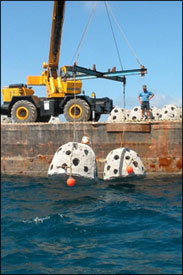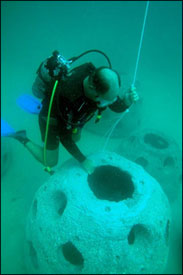|
Lee bounces into Reef Ball project
with sinking off Sanibel
By KEVIN LOLLAR, klollar@news-press.com
Published by news-press.com on June 12,
2004
Lee County’s latest artificial reef, which went down Friday, is a
whole new ballgame — Reef Ball, that is.
 |
2000 lb concrete
Reef Balls were lowered into plce friday morning, creating Lee
County’s newest artificial reef.
Chops Hancock/Special
to news-press.com | For only the second
time, the Lee County Division of Natural Resources has bought
prefabricated modules to make a reef, spending $16,440 on 84
concrete structures called Reef Balls.
Most of the county’s reefs, on 19 sites in the Gulf of Mexico and
Charlotte Harbor, are made from donated material, such as concrete
culverts, bridge rubble and boats.
But Reef Balls, distributed by Reef Innovations Inc., whose
manufacturing plant is in Sarasota, have been getting rave reviews
from Florida and around the world.
One satisfied customer is Nova Southeastern University’s
Oceanographic Center, whose scientists placed Reef Balls in an area
of coral reef off Fort Lauderdale that was damaged when a U.S.
submarine ran aground in 1993.
“We’re using Reef Balls, not as a restoration item per se, but as
a module to test scientific experiments,” said Richard Dodge, dean
of the Oceanographic Center. “We’ve had great success with that as a
module. We like them. They’re doing well. Other people have used
them in other ways, and I think they’ve been successful as well.”
With the attitude of “why buy the cow if the milk’s free?” county
marine biologist Chris Koepfer decided to test the expensive Reef
Balls against reefs made from donated material.
“I’ve been satisfied with how the donated material performs,” he
said. “I really want to compare Reef Balls, which cost a lot of
money, to material that doesn’t cost money to see if there is a
corresponding increase in productivity.
“These things better show me a factor of 10 improvement over the
other stuff.”
Koepfer
chose the ARC Barge reef site, 15 miles off Sanibel in 60 feet of
water, for the experiment because several other artificial reefs are
already there, including a barge, concrete culverts, concrete
pilings, three 25-foot-tall steel radio towers and concrete
tetrahedrons (the first modules the county bought).
Having all these reefs close to the Reef Balls, which look a
little like Hostess Sno Balls with holes (for fish to hide in), will
make comparisons easy.
Using state and federal grants, which cost Lee County taxpayers
nothing, Koepfer bought 24 5-feet-tall, 2-ton Reef Balls and 60 that
are 3 feet tall and 1 ton.
His idea was to create four “patch reefs,” each with six large
modules surrounded by 16 small modules.
The deployment Friday was more difficult than anticipated,
certainly more difficult than most artificial reefs.
With many reefs, including culverts, pilings and bridge rubble,
the material is barged to the site and simply dumped into the water.
But Keopfer’s plan called for the Reef Balls to be placed in
precise relation to one another.
To do that, buoys were tied to the large Reef Balls before they
were lowered by a crane from a McCulley Marine Inc. barge.
The buoys were to show the center of the ring, so the small
modules could be placed accordingly.
But the buoy lines kept getting twisted, slowing down the
process, and county engineering technologists Mike Capps and Paul
Stancati spent much of the day in the water untangling the mess.
 |
Lee County
marine biologist Chris Koepfer checks the county’s new Reef
Balls and artificial reef placed on the Gulf floor Friday
morning.
Chops Hancock/Special to news-press.com
| Another problem was the pins that held the
Reef Balls to the cable often didn’t release when the modules
reached the bottom the first time, and several attempts had to be
made.
Finally, high winds and currents pushed the barge around, making
accurate placement of the modules even more difficult.
Apparently longing for the simpler method of dumping reef
material, Koepfer referred to the Reef Balls several times as “that
fancy schmancy material.”
After 41⁄2 hours of tangled buoy lines and frustration, the Reef
Balls were all in place, not exactly where they were supposed to be,
but close enough.
The first fish visitors were three goliath grouper, five
barracuda and a bar jack, all of which probably swam over from the
nearby radio towers to see what the commotion was all about.
“I’m sure these will make an excellent reef,” Koepfer said. “But
next time I come out, I think I’ll wear socks, because it will have
to knock my socks off to justify the expense.”
Back to Local
& State | 




